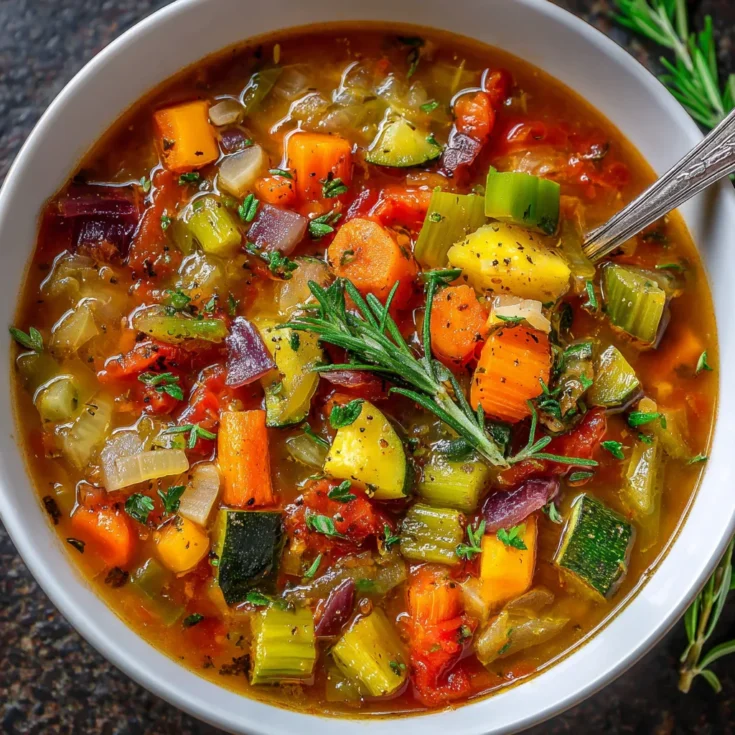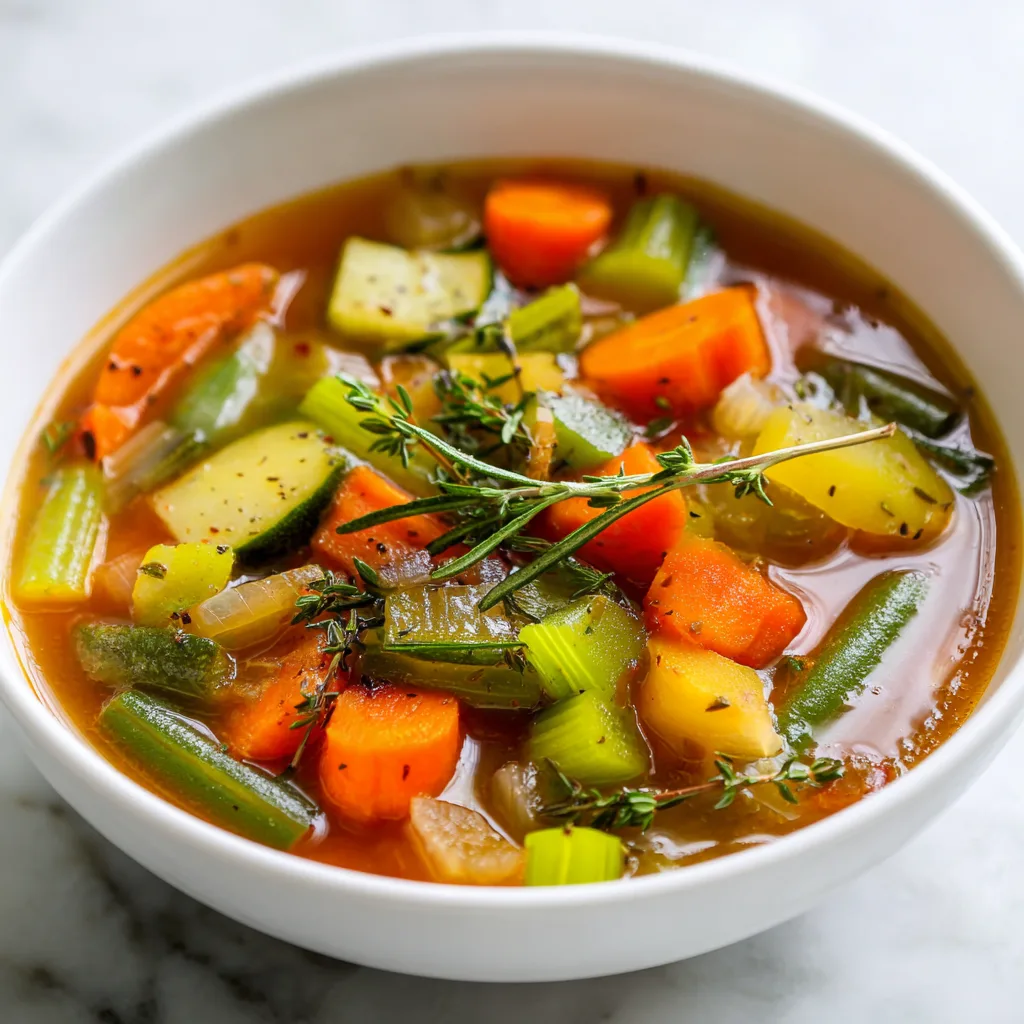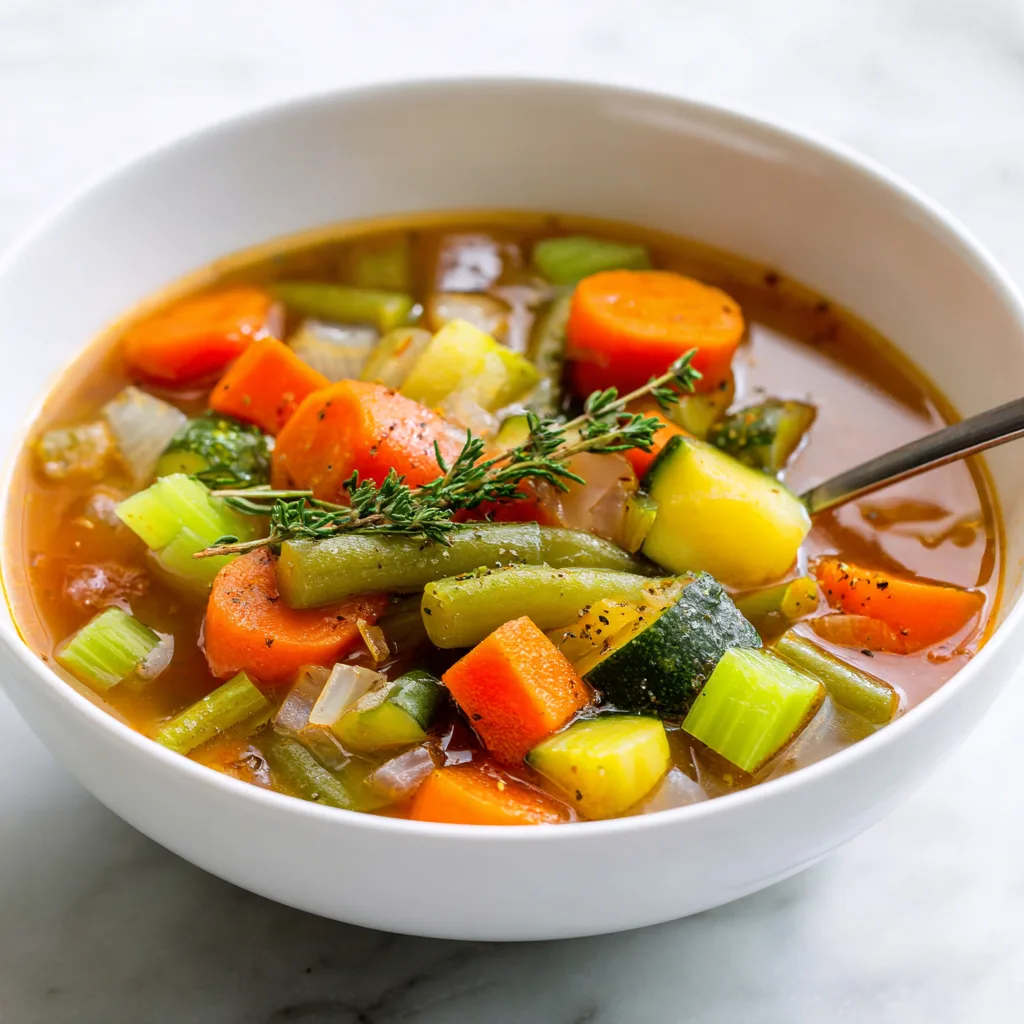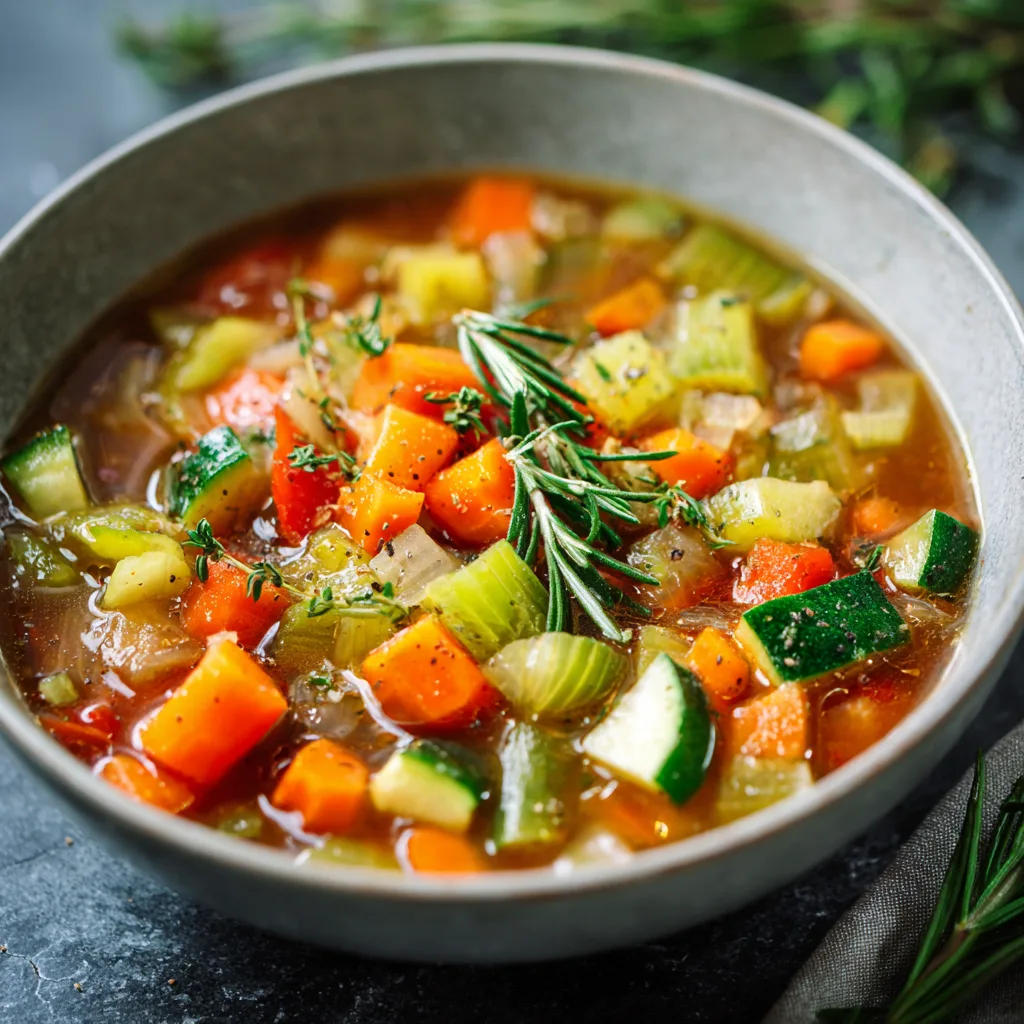Introduction to Slow Cooker Vegetable Feel-Better Soup
What is Slow Cooker Vegetable Feel-Better Soup?
Slow Cooker Vegetable Feel-Better Soup is a warm, hearty dish designed to soothe the body and uplift the spirit. It blends a variety of fresh vegetables cooked gently over several hours in a slow cooker. This method allows flavors to meld beautifully, creating a comforting bowl full of nourishment. The soup offers more than just taste; it’s a remedy for those seeking warmth, wellness, and easy digestion. By combining nutrient-rich vegetables with herbs and spices, it supports the body’s healing processes while providing satisfying comfort.
Why It’s the Ultimate Comfort Food
Slow cooking transforms simple ingredients into a soul-soothing meal. The gentle heat extracts deep flavors from vegetables and herbs, making every spoonful rich and inviting. This cooking style preserves vitamins and minerals better than many quick-cooking methods. Vegetables play a vital role in maintaining a balanced diet, providing essential nutrients, fiber, and antioxidants. These elements promote digestion, boost immunity, and help reduce inflammation. The slow cooker’s convenience adds to the appeal, allowing busy people to prepare a wholesome meal without constant attention.
Who Can Benefit from This Soup?
This soup suits anyone needing a gentle, nourishing meal. It shines during cold weather when warmth and hydration matter most. People recovering from illness will appreciate its easy-to-digest nutrients and soothing warmth. The recipe fits well into vegetarian and vegan lifestyles, making it a versatile choice for those avoiding animal products. Whether you want to boost your wellness or simply enjoy a cozy dinner, Slow Cooker Vegetable Feel-Better Soup meets those needs with flavor and care.
Nutritional Powerhouses in Your Bowl
Vegetables: The Heart of the Soup
Carrots, celery, potatoes, and green beans form the core of this nourishing soup. Each vegetable brings unique benefits that support overall health. Carrots are rich in beta-carotene, which the body converts to vitamin A, essential for eye health and immune function. Celery adds a crisp texture while offering vitamins K and C, along with antioxidants that combat free radicals. Potatoes provide a satisfying source of complex carbohydrates and potassium, helping maintain energy and fluid balance. Green beans supply fiber and vitamins like folate and vitamin C, promoting digestion and boosting immunity. Together, these vegetables create a colorful, nutrient-dense base that supports wellness and satiety.
Herbs and Spices: Nature’s Healing Agents
Garlic, bay leaves, thyme, basil, and oregano don’t just add flavor; they pack a powerful health punch. Garlic acts as a natural immune booster, thanks to its antiviral and antibacterial compounds. Bay leaves contribute antioxidants that protect cells from damage. Thyme and oregano offer anti-inflammatory benefits, reducing the risk of chronic diseases. Basil supports digestion and contains essential oils that soothe discomfort. These herbs and spices enrich the soup’s taste while enhancing its healing properties, making every spoonful both tasty and therapeutic.
Broth Base: The Flavor and Nutrition Foundation
Choosing a quality broth elevates the soup’s taste and nutrition. Vegetable broth offers vitamins and minerals with fewer calories and no animal products, making it perfect for plant-based diets. Chicken broth adds protein and minerals like calcium and magnesium, which support bone health. Both broths provide a savory depth that ties ingredients together. The liquid base also hydrates and delivers nutrients efficiently, turning simple vegetables into a satisfying meal.
Optional Add-ins: Boosting Protein and Texture
To make the soup even more filling and nutritionally balanced, beans, lentils, or quinoa can join the mix. Beans and lentils supply plant-based protein and fiber, helping regulate blood sugar and support digestive health. Quinoa offers a complete protein with all nine essential amino acids, making it ideal for vegetarians. These add-ins enhance the soup’s texture and ensure it fuels your body with the energy and nutrients it needs to feel better and stay strong.
Step-by-Step Guide to Making Slow Cooker Vegetable Feel-Better Soup
Preparing the Ingredients: Setting the Foundation
Start by washing and chopping all your vegetables evenly. Uniform pieces ensure they cook at the same rate, preventing some from becoming mushy while others stay undercooked. Peel carrots and potatoes for a smoother texture, or leave the skin on for added fiber and nutrients. Mince garlic finely to release its full aroma. Take time to prep herbs like thyme and bay leaves so they infuse the soup thoroughly. Proper prep saves time during cooking and helps develop balanced flavors.
Layering in the Slow Cooker: Building Depth
Place harder vegetables like potatoes, carrots, and celery at the bottom of the slow cooker. These need more time to soften. Add softer vegetables, such as zucchini and green beans, on top so they don’t overcook. Pour the broth over the layers to distribute heat evenly. Season lightly at this stage with salt, pepper, and dried herbs. You can adjust seasoning later, but early seasoning helps flavors penetrate the ingredients during slow cooking.
Cooking Time and Settings: Perfect Timing
Set your slow cooker to low heat for about 6 hours to allow flavors to meld slowly and vegetables to soften without losing texture. If short on time, use the high setting for 3 to 4 hours, but monitor to avoid overcooking. Root vegetables take longer to become tender, so starting with a low setting ensures even cooking. Check the soup’s consistency near the end and adjust cooking time as needed. Slow cooking brings out the best in simple ingredients.
Enhancing Flavor: Balancing and Layering Tastes
Once cooking finishes, taste the soup and adjust the seasoning. Add salt gradually to avoid overpowering flavors. A splash of lemon juice or a dash of vinegar brightens the broth and balances richness. If the soup feels flat, a pinch of sugar can round out acidity from tomatoes or vinegar. Fresh herbs added at the end revive the aroma and color. For extra depth, simmer the soup uncovered for 15 minutes to concentrate flavors. These small adjustments turn a simple soup into a comforting masterpiece.
Making the Soup Your Own
Adjusting for Dietary Preferences: Inclusive and Flexible
This soup easily adapts to many dietary needs. For a vegan version, use vegetable broth and skip any animal-based add-ins. To keep it gluten-free, avoid pasta or grains containing gluten; instead, try quinoa or rice. Those watching sodium levels can select low-sodium broth and reduce added salt. Feel free to swap vegetables based on allergies or preferences. Cauliflower can replace potatoes for lower carbs, or sweet potatoes add natural sweetness and fiber. These simple substitutions keep the soup accessible and enjoyable for everyone.
Flavor Variations: Spice It Up Your Way
Experimenting with spices and herbs can breathe new life into your soup. Adding cumin introduces a warm, earthy tone, while turmeric offers both vibrant color and anti-inflammatory benefits. Smoked paprika lends a subtle smoky depth without overwhelming the vegetables. Fresh herbs like cilantro, parsley, or dill create unique flavor profiles and brighten the dish. Try mixing and matching spices to suit your mood and bring variety to your slow cooker meals.
Texture Modifications: From Chunky to Creamy
Adjust the soup’s texture to match your preference. For a silky, creamy version, blend part or all of the soup using an immersion blender or regular blender. This smooths out vegetables and creates a comforting, velvety broth. If you prefer a heartier meal, add cooked grains like barley, quinoa, or small pasta shapes toward the end of cooking. These ingredients add chew and make the soup more filling, perfect for cold days or when you need extra energy.
Seasonal Adaptations: Freshness All Year Round
Take advantage of seasonal vegetables to keep your soup fresh and flavorful throughout the year. In spring, incorporate asparagus, peas, or new potatoes. Summer calls for zucchini, fresh tomatoes, and green beans. Fall and winter offer root vegetables, squash, and kale. Adjust cooking times slightly depending on the density of your chosen vegetables. Using seasonal produce not only enhances flavor but also supports sustainable cooking practices. This way, your slow cooker soup stays vibrant and nourishing no matter the season.
Enjoying and Preserving Your Soup
Serving Ideas: Elevate Your Meal
Slow Cooker Vegetable Feel-Better Soup pairs wonderfully with simple sides that enhance its comforting flavors. A slice of crusty bread or a warm baguette complements the soup’s hearty texture and adds satisfying crunch. Fresh salads provide a crisp contrast and boost the meal’s nutritional value. For a more indulgent touch, serve the soup alongside a grilled cheese sandwich; the melted cheese balances the lightness of the broth. Garnishing your soup with fresh herbs like parsley or cilantro adds a pop of color and freshness. A dollop of plain yogurt or sour cream also brings creaminess and a subtle tang that brightens each spoonful.
Storing Leftovers: Keep It Fresh
To store leftovers, allow the soup to cool to room temperature before refrigerating. Transfer it into airtight containers and consume within three to four days for optimal freshness. For longer storage, freeze the soup in freezer-safe containers or heavy-duty zip-top bags, leaving some space for expansion. Label containers with the date to keep track. When reheating, thaw frozen soup overnight in the fridge, then warm it gently on the stove over low heat. Stir occasionally to prevent sticking and add a splash of broth or water if the soup thickens too much. Avoid microwaving for long periods, as it can cause uneven heating and affect texture.
Meal Prep Tips: Save Time and Effort
Meal prepping can make enjoying this soup even easier. Chop vegetables and measure spices ahead of time, then store them in separate containers or bags in the refrigerator. This way, you can quickly dump ingredients into the slow cooker without extra prep on busy days. You can also prepare larger batches of broth or stock and freeze them in portions to speed up cooking. If you plan to add grains or pasta, keep them separate until just before serving to avoid sogginess. These tips streamline the cooking process, helping you enjoy a wholesome, homemade meal with minimal effort.
Frequently Asked Questions
Can I use frozen vegetables?
Yes, frozen vegetables work well in this soup. You may need to adjust the cooking time slightly to avoid overcooking softer vegetables.
How can I make the soup spicier?
To add heat, try red pepper flakes, cayenne pepper, or a diced jalapeño. Add gradually and taste to reach your desired spice level.
Can I make this soup ahead of time?
Absolutely. Prepare the soup in advance and store it in the refrigerator for up to four days or freeze portions for longer storage.
How do I reheat leftovers?
Reheat the soup gently on the stove over low heat. Stir occasionally and add a splash of broth or water if it thickens too much.
Can I add meat to this soup?
Yes, cooked chicken or turkey can be added for a non-vegetarian option. Add meat toward the end of cooking to prevent overcooking.
Slow Cooker Vegetable Feel-Better Soup – Healthy, Nourishing & Easy

This hearty and nourishing soup combines a variety of fresh vegetables, aromatic herbs, and spices. Slow-cooked to perfection, it delivers a comforting and flavorful meal that warms both body and soul.
Ingredients
- 1 onion, chopped
- 2 carrots, peeled and sliced
- 2 celery stalks, chopped
- 2 potatoes, peeled and diced
- 1 cup green beans, chopped
- 1 zucchini, chopped
- 1 (15 oz) can diced tomatoes
- 4 cups vegetable broth
- 2 cloves garlic, minced
- 1 teaspoon dried thyme
- 1 teaspoon dried basil
- 1 bay leaf
- Salt and pepper to taste
Instructions
Notes




